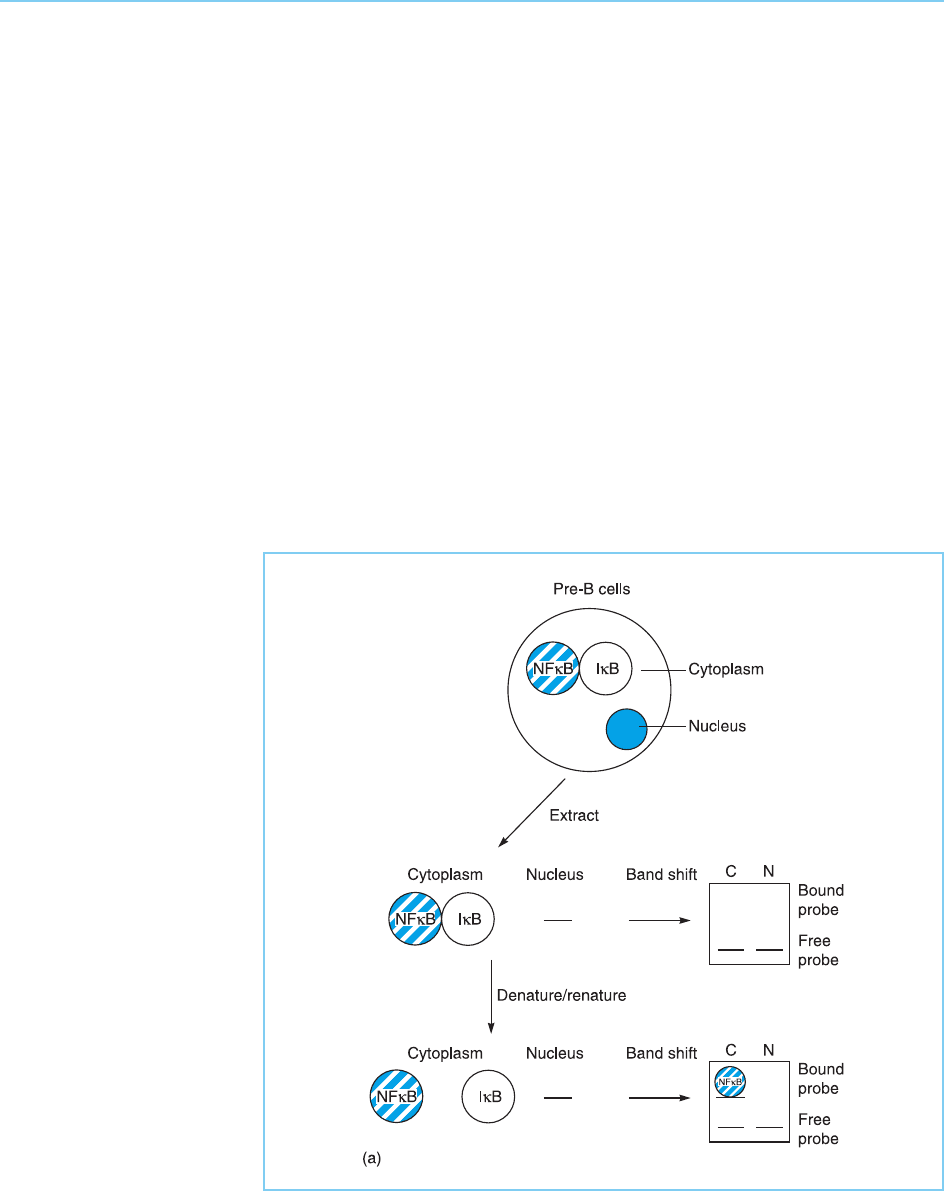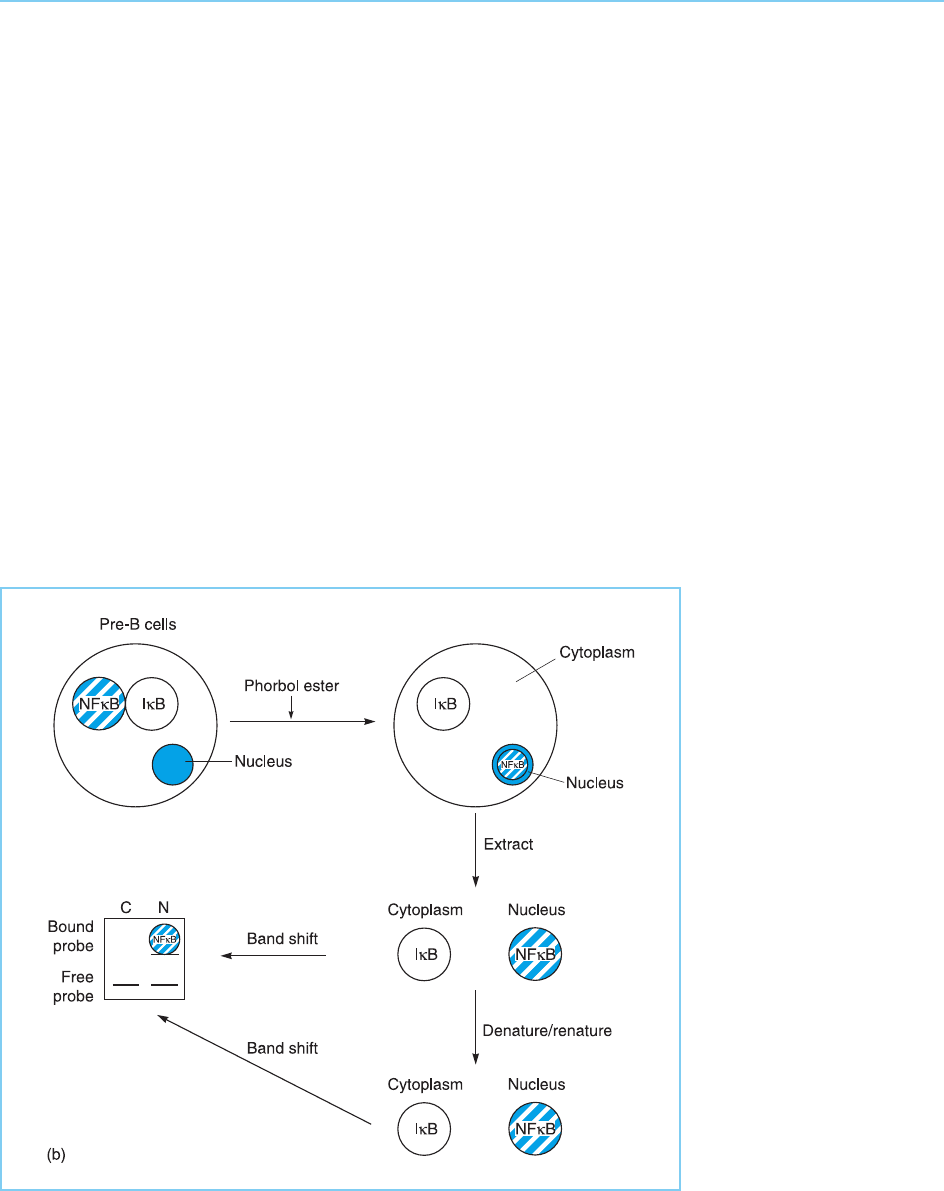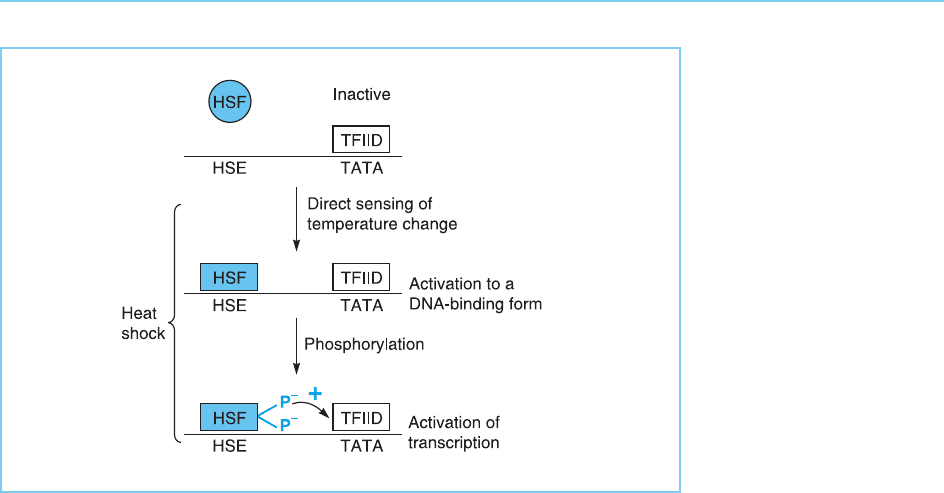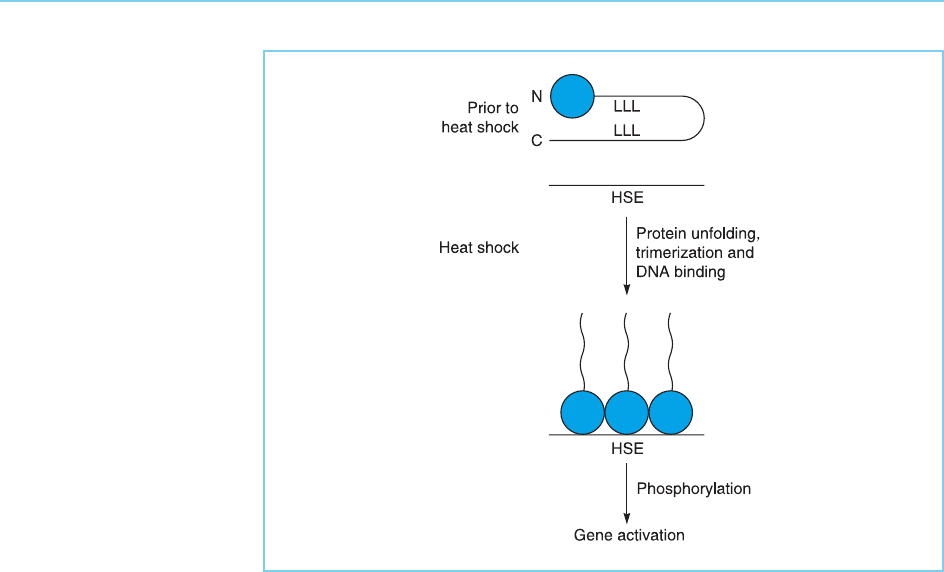Latchman. Eukariotic Transciption Factors
Подождите немного. Документ загружается.


This complex is dissociated upon steroid treatment releasing the 4S receptor
protein (for reviews see Pratt, 1997; Pratt and Toft, 1997). The released
receptor is free to dimerize and move into the nucleus. Since these processes
have been shown to be essential for DNA binding and transcriptional activa-
tion by steroid hormone receptors, dissociation of the receptor from hsp90 is
essential if gene activation is to occur. In agreement with this antiglucocorti-
coids, which inhibit the positive action of glucocorticoids, have been shown to
stabilize the 8S complex of hsp90 and the receptor.
Similar complexes with hsp90 have also been reported for the other steroid
hormone receptors. Thus the activation of the different steroid receptors such
as the glucocorticoid and oestrogen receptors by their specific hormones is
likely to involve disruptio n of the protein–protein interaction with hsp90
(Fig. 8.7).
Most interestingly, the association of hsp90 with the glucocorticoid recep-
tor occurs vi a the C-terminal region of the receptor, which also contains the
steroid binding domain. It has been suggested therefore that by associating
with the C terminal region of the receptor, hsp90 masks adjacent domains
whose activity is necessary for gene activation by the receptor for example,
those involved in receptor dimerization or subsequent DNA binding, thereby
preventing DNA binding from occurring. Following steroid treatment, how-
ever, the steroid binds to the C terminus of the receptor displacing hsp90 and
thereby unmasking these domains and allowing DNA binding to occur
(Fig. 8.8). Hence, activation of the steroid receptors involves a ligand-induced
conformational change which results in the dissociation of an inhibitory
protein.
REGULATION OF TRANSCRIPTION FACTOR ACTIVITY 251
Figure 8.6
Comparison of steroid
receptor binding to DNA
in the presence or
absence of hormone in
vivo and in vitro. Note
that while in vivo DNA
binding can occur only in
the presence of
hormone, in vitro, it can
occur in the presence or
absence of hormone.

252 EUKARYOTIC TRANSCRIPTION FACTORS
Figure 8.7
Activation of the
glucocorticoid receptor
(GR) by steroid involves
dissociation of hsp90
allowing dimerization and
movement to the nucleus.
Figure 8.8
Interaction of hsp90 and
the glucocorticoid
receptor. hsp90 binds to
the receptor via the C
terminal region of the
receptor which also binds
steroid and may mask
regions of the receptor
necessary for dimerization
or DNA binding. When
steroid is added it binds
to the receptor at the C
terminus displacing hsp90
and exposing the masked
regions.

In addition to the steroid-induced dissociation of the receptors from hsp90
it is clear that a second step following dissociation from hsp90 is also required
for receptor activation. Thus in a cell-free system in which the progesterone
receptor exists in a 4S form, free of bound hsp90, the addition of progester-
one is still required for the activation of progesterone responsive genes. This
indicates that the hormone has an additional effect on the receptor apart from
dissociating it from hsp90. This effect involves the unmasking of a previously
inactive transcriptional activation domain in the receptor allowing it to acti-
vate gene expression in a hormone-dependent manner following DNA bind-
ing. Thus, domain swopping experiments (see Chapter 2, section 2.4.1) have
identified C-terminal regions in both the glucocorticoid and oestrogen recep-
tors which, when linked to the DNA binding domain of another factor, can
activate transcription only following hormone addition (see Fig. 4.29). These
regions hence constitute hormone-dependent activation domains.
Moreover, in the case of the oest rogen receptor, it has been shown that the
oestrogen antagonist 4-hydroxytamoxifen induces the receptor to bind to
DNA (presumably by promoting dissociation from hsp90 and dimerization),
but does not induce gene activation suggesting that it fails to activate the
oestrogen-responsive transactivation domain. Hence the mechanism by
which the steroid receptors are activated is now thought to involve both dis-
sociation from hsp90 and a change in their transcriptional activation ability
(Fig. 8.9a). This second step is likely to involve a change in the activation
domain which allows it to bind co-activator proteins that are essential for
transcriptional activation (see Chapter 5, sect ion 5.4.3 for discussion of co-
activator molecules).
Interestingly, other members of the nuclear receptor family which bind to
substances that are related to steroids, such as retinoic acid or thyroid hor-
mone, do not associate with hsp90 and are bound to DNA prior to exposure
to ligand. Their activation by their appropriate ligand thus involves only the
second stage discussed above, namely a ligand-induced structural change in
their C-terminal activation domain, which is adjacent to the ligand binding
domain, allowing it to bind co-activator molecules and activate transcription
(Fig. 8.9b). Indeed, crystallographic studies of the ligand binding domain and
the C-terminal activation domain of the retinoic acid receptors, both in the
presence or absence of hormone, have provided direct evidence for this
change. Thus, as illustrated in Plate 7, the activation domain is not closely
associated with the ligand binding domain in the absence of ligand but is
much more closely associated with it following ligand binding and forms a
lid covering the ligand binding region (Renaud et al., 1996).
Although first defined in the retinoic acid receptors, a similar structural
change occurs upon ligand binding in other members of the nuclear receptor
REGULATION OF TRANSCRIPTION FACTOR ACTIVITY 253

family including the glucocorticoid and oestrogen receptors and the thyroid
hormone receptor (Wurtz et al., 1996). Indeed, it has been shown that while
oestrogen induces this realignment of the oestrogen receptor activation
domain, the oestrogen antagonist raloxifene does not do so, thereby explain-
ing its antagonistic action (Brzozowki et al., 1997) (Fig. 8.10). In turn this
ligand-induced structural change allows the activation domain to bind co-
activator proteins, which bind to the receptors only after exposure to
hormone and appear to play a key role in the ability of the receptors to
activate transcription (see Fig. 8.9) (see Chapter 5, section 5.4.3 for a dis-
cussion of co-activator molecules).
Interestingly, in the case of receptors such as the thyroid hormone recep-
tor, where DNA binding is observed even prior to hormone treatment, the
receptor actually represses transcription prior to thyroid hormone treatment.
As di scussed in Chapter 6 (section 6.3.2), this is because in the absence of
ligand, the receptor binds co-repressor molecules which are displaced by co-
254 EUKARYOTIC TRANSCRIPTION FACTORS
Figure 8.9
(a) Activation of the
steroid receptors (SR) by
treatment with steroid. As
well as inducing
dissociation of the
receptor from hsp90,
steroid treatment also
increases the ability of the
receptor to activate
transcription following
DNA binding by changing
the structure of the
activation domain (shaded)
allowing it to bind co-
activator proteins (CA)
which stimulate
transcription. (b) Activation
of other members of the
nuclear receptor family
which bind non-steroids
such as retinoic acid or
thyroid hormone involves
only the second of these
stages.

activators on hormone treatment. The importance of this conversion from
repressor to activator is seen in the case of mutant forms of the thyroid
hormone receptor which cannot undergo this conformational change because
they do not bind thyroid hormone. This is observed not only in the v-erbA
oncogene as discussed in Chapter 9 (section 9.3.2) but also in patients with
generalized thyroid hormone resistance. Thus these patients have been shown
to produce forms of the receptor which can repress gene expression but
which cannot activate genes in response to thyroid hormone. Most interest-
ingly, the presence of these dominant negative forms of the receptor results in
impairment of physical and mental development which is much more severe
than that observed if the receptor is absent completely (Baniahmad et al.,
1992).
Hence, in all the nuclear receptors, activation by ligand involves a struc-
tural change in the C-terminal activation domain which allows it to bind co-
activators. In the steroid hormone receptors, this is preceded by an earlier
step which involves the disruption of the receptor hsp90 association.
Activation of these steroid receptors, therefore involves both the ligand-
induced conformational changes seen in ACE1 and DREAM as well as the
dissociation of an inhibitor protein and thus combines the mechanisms illu-
strated in Figure 8.2a and b.
8.3 REGULATION BY PROTEIN–PROTEIN INTERACTIONS
8.3.1 INHIBITION OF TRANSCRIPTION FACTOR ACTIVITY BY
PROTEIN–PROTEIN INTERACTION
As described above, the glucocorticoid receptor is regulated by its interaction
with hsp90 which prevents it binding to DNA and activating transcription in
the absence of steroid hormone. A similar mechanism is used in the case of
the NFB factor which, as discussed above, only activates transcription in
mature B cells or in other cell types following treatment with agents such as
REGULATION OF TRANSCRIPTION FACTOR ACTIVITY 255
Figure 8.10
(a) The binding of the
ligand (L) induces the
realignment of the C-
terminal activation domain
of the nuclear receptors
(light shading) so that it
forms a lid over the ligand
binding domain and the
activation domain then
stimulates transcription.
(b) This realignment is not
induced by binding of
antagonists (A) which
therefore do not stimulate
transcriptional activation.

lipopolysaccharides or phorbol esters. In agreement with this, no active form
of NF B capable of binding to DNA can be detected in DNA mobility shift
assays (see Chapter 2, section 2.2.1) using either cytoplasmic or nuclear
extracts prepared from pre-B cells or non-B cell types. Interestingly, however,
such activity can be detected in the cytoplasm but not the nucleus of such cells
following denaturation and subsequent renaturation of the proteins in the
extract. Hence NFB exists in the cytoplasm of pre-B cells and other cell types
in an inactive form which is complexed with another protein known as IB
that inhibits its activity (for reviews see Karin and Ben-Neriah, 2000; Perkins,
2000; Dixit and Mak, 2002). The release of NFB from IB by the denatura-
tion/renaturation treatment therefore results in the appearance of active
NFB capable of binding to DNA (Fig. 8.11a).
These findings suggested therefore that treatments with substances such as
lipopolysaccharides or phorbol esters do not activate NF B by interacting
directly with it in a manner analogous to the activation of the ACE1 factor
by copper. Rather they are likely to produce the dissociation of NFB from
256 EUKARYOTIC TRANSCRIPTION FACTORS
Figure 8.11a
Regulation of NFB.
Panel (a) In pre-B cells
NFB is located in the
cytoplasm in an inactive
form which is complexed
to IB. DNA mobility
band shift assays do not
therefore detect active
NFB. If a cytoplasmic
extract is first denatured
and renatured, however,
active NFB will be
released from IB and will
be detected in a
subsequent band shift
assay.

IB resulting in its activation. In agreement with this idea, phorbol ester
treatment of cells prior to their fractionation eliminated the latent NFB
activity in the cytoplasm and resulted in the appearance of active NFBin
the nucleus (Fig. 8.11b). These substances act therefore by releasing NF B
from IB allowing it to move to the nucleus where it can bind to DNA and
activate gene expression. Hence this constitutes an example of the activation
of a factor by the dissociation of an inhibitory protein (see Fig. 8.2b).
Such a mechanism is used to regulate the activity of many different tran-
scription factors. Thus apart from the NF B/IB and glucocorticoid recep-
tor/hsp90 interactions, other examples of inhibitory interactions include
those between DNA binding helix-loop-helix proteins and Id (Chapter 6,
section 6.2.2) and p53 and the MDM2 protein (Chapter 9, section 9.4.2).
Hence inhibitory intera ctions of this type are widely used to regulate the
activity of specific transcription factors.
A highly comp lex example of such regulation by protein–protein interac-
tion is seen in the case of the heat shock factor (HSF) which, as discussed in
Chapter 5 (section 5.5.1) activates gene transcription in response to elevated
REGULATION OF TRANSCRIPTION FACTOR ACTIVITY 257
Figure 8.11b
Panel (b) In mature B
cells, NFB has been
released from IB and is
present in the nucleus in
an active DNA-binding
form. It can therefore be
detected in a DNA
mobility shift assay
without a denaturation,
renaturation step which
has no effect on the
binding activity.

temperature. HSF achieves this effect by binding to its binding site in target
genes, which is known as the heat shock element (HSE) (see Chapter 1, sec-
tion 1.3.3). The amount of HSF bound to the HSE increases with the time of
exposure to elevated temperature and with the extent of temp erature eleva-
tion. Moreover , increased protein binding to the HSE is also observed follow-
ing exposure to other agents which also induce the transcription of the hea t
shock genes, such as 2,4-dinitrophenol (Fig. 8.12). Thus, activation of the heat
shock genes, mediated by the HSE is accompanied by the binding of a specific
transcription factor to this DNA sequence.
As noted in section 8.1, this activation of HSF can occur in the absence of
new HSF protein synth esis (for review see Morim oto, 1998). Thus, if cells are
heat treated in the presence of cycloheximide, which is an inhibitor of protein
synthesis, increased binding of HSF to the HSE is observed exactly as in cells
treated in the absence of the drug (Zimarino and Wu, 1987). This indicates
that the observed binding of HSF following heat shock does not require de
novo protein synthesis. Rather, this factor must pre-exist in non-heat treated
cells in an inactive form whose ability to bind to the HSE sequence in DNA is
activated post-translationally by heat. In agreement with this, activation of
HSF can also be observed following heat treatment of cell extracts in vitro
when new protein synthesis would not be possible (Larson et al., 1988).
Analysis of the activation process using in vitro systems from human cells
(Larson et al., 1988) has indicated that it is a two-stage process (Fig. 8.13). In
258 EUKARYOTIC TRANSCRIPTION FACTORS
Figure 8.12
Detection of HSF binding
to the HSE 91 bases
upstream (-91) of the
start site for transcription
in the Drosophila hsp82
gene and protecting this
region from digestion with
exonuclease III. Note the
increased binding of HSF
with increasing time of
exposure to heat shock
or increased severity of
heat shock. HSF binding
is also induced by
exposure to 2, 4-
dinitrophenol (DNP)
which is known to induce
transcription of the heat
shock genes.

the first stage, the HSF is activated to a form which can bind to DNA by an
ATP-independent mechanism which is directly dependent on elevated tem-
perature. Subsequently, this protein is further modified by phosphorylation
allowing it to activate transcription. Interestingly, the second of these two
stages appears to be disrupted in murine erythroleukaemia (MEL) cells in
which heat shock results in increased binding of HSF to DNA but transcrip-
tional activation of the heat shock genes is not observed (Hensold et al., 1990).
The activation of HSF into a form capable of binding DNA involves its
conversion from a monomeric to a trimeric form which can bind to the
HSE (for review see Morimoto, 1998). The main tenance of the monomeric
form of HSF prior to heat shock is dependent on a region at the C terminus of
the molecule since when this region is deleted, HSF spontaneously trimerizes
and can bind to DNA even in the absence of heat shock (Rabindran et al.,
1993). The C-terminal region contains a leucine zipper (see Chapter 4, section
4.5). As leucine zippers are known to be able to interact with one anot her, it is
thought that this region acts by interaction wit h another leucine zipper
located adjacent to the N-terminal DNA binding domain promoting intramo-
lecular folding which masks the DNA binding domain. Following heat shock
HSF unfolds, unmasking the DNA binding domain and allowing a DNA-bind-
ing trimer to form (Fig. 8.14).
Recent studies have also shown that the transition of HSF from monomer
to trimer requires two specific cysteine residues within HSF. These cysteine
residues are thought to promote this transition by forming disulphide
REGULATION OF TRANSCRIPTION FACTOR ACTIVITY 259
Figure 8.13
Stages in the activation
of HSF in mammalian
and Drosophila cells.
Initial activation of HSF
to a DNA-binding form
following elevated
temperature is followed
by its phosphorylation
which converts it to a
form capable of activating
transcription.

bonds with one another in response to heat or other stresses, although it is
currently unclear whether these bonds form between the cysteines in one
molecule of HSF or between different molecules in the trimer (Ahn and
Thiele, 2003).
Interestingly, as with the glucocorticoid receptor (see section 8.2.2), the
conversion of HSF from a monomer to a DNA-binding trimer involves the
dissociation of hsp90 which binds to HSF in untreated cells and stabilizes it in
the ina ctive form which cannot bind to DNA (Zou et al., 1998). Interestingly,
hsp90 acts as a so-called ‘chaperone’ protein, assisting the proper folding of
other proteins. Evidently, following heat or other stress, the level of such
unfolded proteins will increase. Hsp90 will therefore be ‘called away’ to
deal with these unfolded proteins leaving HSF free to trimerize and bind to
DNA (Fig. 8.15).
Hence, the response of HSF to stress involves both the loss of an inhibitory
protein and changes in the HSF molecule itself. Together these changes pro-
mote the transition from an HSF monomer to a DNA binding trimer.
However, this DNA binding by HSF is insufficient to produce transcriptional
activation. This requires phosphorylation of HSF on serine 230 which allows
the DNA bound form of HSF to activate transcription (see Figs. 8.14, 8.15)
(Holmberg et al., 2001).
260 EUKARYOTIC TRANSCRIPTION FACTORS
Figure 8.14
Prior to heat shock, HSF
is present in a monomeric
form in which the leucine
zipper motifs (L) at the C-
terminus and within the
molecule promote intra-
molecular folding which
masks the N-terminal
DNA binding domain
(shaded) preventing
binding to the HSE.
Following heat shock, the
protein unfolds and forms
the DNA binding trimeric
form. This form binds to
the HSE and activates
transcription following its
subsequent
phosphorylation.
